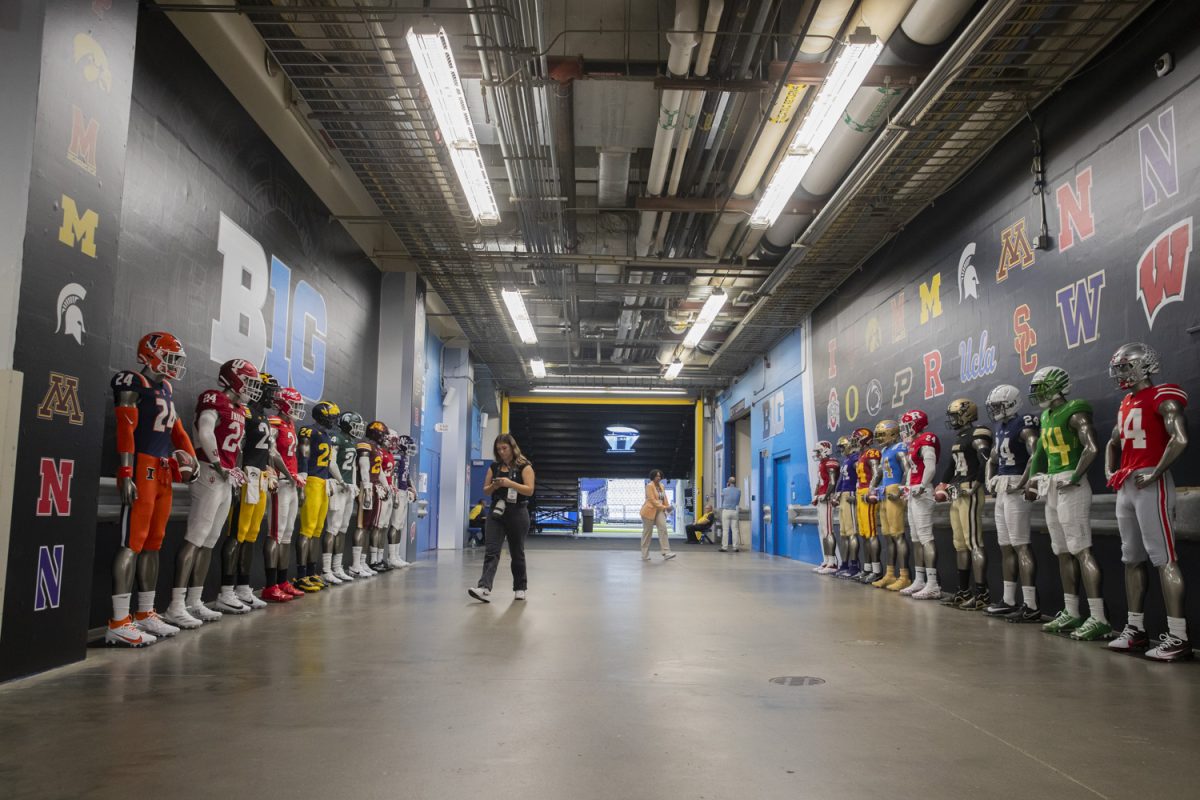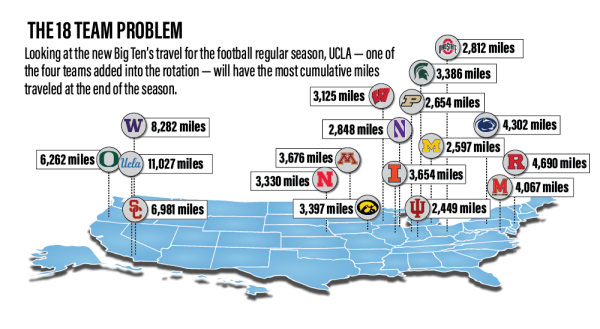
Isabella Tisdale
Jerseys from all 18 Big Ten schools are displayed in the hallway during day one of Big Ten Football Media Day's at Lucas Oil Stadium in Indianapolis, Ind., on July 23. The expansion in the Big Ten, adding four West Coast schools, started in June of 2022, when admittance was granted to USC and UCLA.
Washington football safety Kamren Fabiculanan was fielding questions with ease. Sitting at the podium inside Lucas Oil Stadium in Indianapolis, the well-dressed and bespectacled Fabiculanan delved into how the Huskies were responding to their new head coach and defensive coordinator.
But when asked by a Daily Iowan reporter how many cities in the state of Iowa he could name off the top of his head, the safety kept his answer succinct.
“Iowa. That’s it,” he said with a smile.
Hailing from Camarillo, California, the defensive back grew up more than 1,800 miles from Kinnick Stadium. A trip from his Washington campus to the Iowa Pentacrest is a 27-hour drive. For most of his life, Fabiculanan had no reason to know anything about Iowa or the Midwest. For his first five years with the Huskies, the senior most likely viewed the Big Ten as a potential bowl game opponent — not a conference foe to prepare for every week.
Yet such is the case in the 2024-25 college football season, where former PAC-12 squads Washington, Oregon, USC, and UCLA will compete in an 18-team Big Ten Conference complete with a longer season, more travel, and a plethora of unfamiliar experiences. Football and Olympic sports student-athletes, coaches, and administrators are left to navigate this new landscape and embrace it for its challenges but also its unprecedented opportunities.
From Power Five to Power Four
The additions of the four West Coast schools started on June 30, 2022, when USC and UCLA were granted admittance to the Big Ten via a unanimous vote by conference presidents and chancellors. The two schools would officially make the transition on Aug. 2, 2024.
“We want to position our student-athletes at UCLA to be the best and to be in a position of strength,” Jarmond said in a 2022 interview on SportsCenter. “We have 119 national championships, and it’s important to support all 25 of our programs. At the end of the day, with this seismic change in college athletics, we want to be in a position of strength at UCLA, and that’s what we intend to do.”
For the Trojans and Bruins — who had been with the PAC-12 since 1922 and 1928, respectively — the move was a stark break of tradition but offered the lucrative luxury of reaping in a share of the new Big Ten media rights deal. The PAC-12’s $3 billion deal with ESPN and FOX was set to expire at the end of the 2023 season, and the conference was still in the process of finding a future suitor.
The Big Ten’s agreement — spanning seven years and shelling out $7 billion from NBC, FOX, and CBS — was signed on Aug. 18, 2022. USC and UCLA would each receive a piece of the pie, which ESPN’s Adam Rittenberg reported would be between $80-$100 million a year.
That share would dwindle a little more than a year later as Oregon and Washington jumped ship on Aug. 4, 2023. That same day, fellow PAC-12 schools Arizona, Arizona State, Utah, and Colorado joined the Big 12. The PAC-12 was down to two teams — Oregon State and Washington State — and left scrambling for a media rights deal.
The PAC-12 would eventually sign a one-year deal with FOX and The CW in May 2024 and will add new teams in the future. Former Mountain West schools Boise State, Colorado State, Fresno State, Utah State, and San Diego State are set to join in the summer of 2026, as will former West Coast Conference powerhouse Gonzaga, which doesn’t have a football team but is known for its talent in basketball.
When college football kicked off the 2024-25 season, the Power Five — a term used to describe the NCAA premier Division I conferences — was now the Power Four, with the Big Ten as an 18-team superconference complete with a sharp uptick in quality competition.
On the gridiron, all four of the incoming schools had winning records in 2023, with Oregon and Washington battling in the PAC-12 title game in December.
Despite its coach leaving for the Alabama job in the offseason and star quarterback Michael Penix Jr. departing to the NFL, Washington is 4-2 and 2-1 in Big Ten play.
The Ducks boasted the second-best offense in the nation in 2023, averaging 44.2 points and 346.9 yards per game. Head Coach Dan Lanning made a splash in the transfer portal, signing Oklahoma quarterback Dillon Gabriel for his final season of college eligibility. Gabriel ranks 16th in the nation in passing efficiency, completing 77.8 percent of his passes for 1,449 yards and 11 scores as the Ducks have broken out to a 5-0 mark this season.
Oregon ranks No. 3 in the nation in the most recent Associated Press poll, while USC and UCLA are unranked. The Trojans picked up an impressive road win against LSU in Week 1, but have struggled on the road against Big Ten foes, dropping decisions to Minnesota and Michigan. Meanwhile, UCLA and new head coach Deshaun Foster have dropped five straight contests by a combined 20.75 points. Despite the four new schools’ varying degrees of success, they are each united in the challenge of travel.
Coast-to-coast action
According to a study from Ben Mendelowitz of Action Sports Network, UCLA will travel the second-farthest for any Division I football team this fall, totaling 11,027 miles across its 12 regular season games. The Bruins have played road matchups against Hawaii, LSU, and as part of their Big Ten slate, will fly out east to Penn State, Rutgers, and Nebraska.
Out of the top 10 schools in mileage, the Big Ten features the second most, trailing the Mountain West. Behind UCLA is Washington in fifth place with 8,832 miles and USC following with 6,981. Sitting at No. 13 is Oregon, which will fly 6,262 miles.

Every Big Ten school falls within the top 110, with 13 of the 18 institutions sitting in the top 75. For second-year conference commissioner Tony Petitti, building schedules is a collaborative process involving coaches, university administrators, and even Big Ten leadership at the presidential level.
“We’ve taken a lot of care to try to minimize travel where we can,” he told reporters at 2024 Big Ten Football Media Days in July. “I will tell you that we feel really good about where we’ve ended up across all of our sports.”
“Having said that, I really believe that scheduling is something that has to be constantly evaluated by sport, and I anticipate that we’ll get, hopefully, a lot more right these next couple of years with the way we’ve formatted and scheduled,” he continued. “But it’s our responsibility and our job to listen to student-athletes, to listen to coaches to make sure that we’re adjusting and making the changes we need.”
Petitti said it would be reasonable to assume future alterations, but based on testimony from head coaches and administration, the extra travel doesn’t pose too much of a burden.
In an August interview with The Los Angeles Times, UCLA Athletic Director Jarmond said travel would be “incremental, not seismic.” He noted that most sports will have one or two trips per year to a different time zone. The Bruins football team has five trips to a different time zone — Hawaii, Penn State, Rutgers, LSU, and Nebraska — but only three take place during the UCLA school year.
!function(){“use strict”;window.addEventListener(“message”,(function(a){if(void 0!==a.data[“datawrapper-height”]){var e=document.querySelectorAll(“iframe”);for(var t in a.data[“datawrapper-height”])for(var r=0;r
